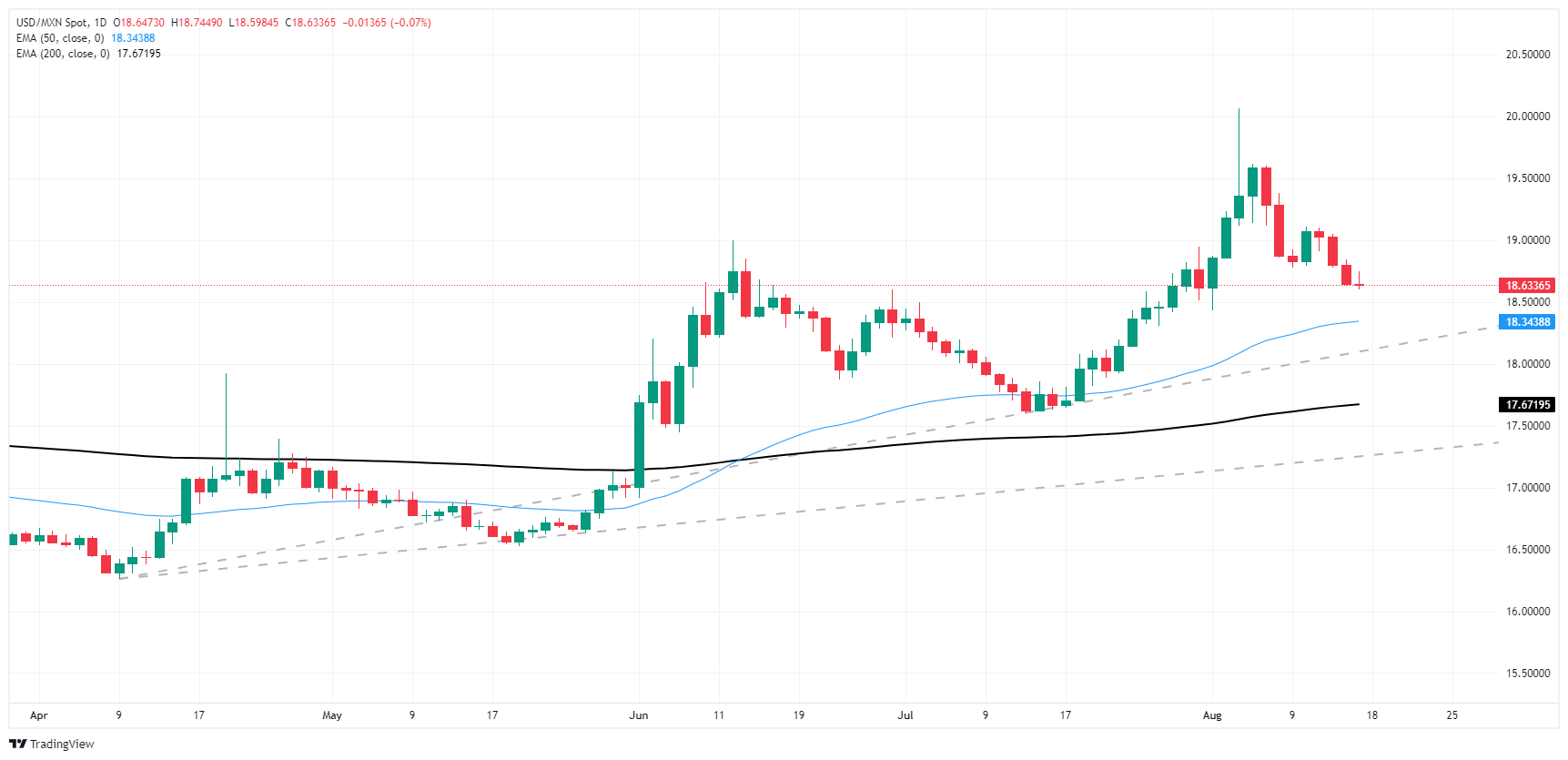- Analytics
- News and Tools
- Market News
- Mexican Peso struggles to add in a fourth gain in a row
Mexican Peso struggles to add in a fourth gain in a row
- The Mexican Peso is holding on the high side on Friday.
- An uptick in US consumer sentiment has bolstered market risk appetite.
- Hopes for a September Fed rate cut remain high.
The Mexican Peso (MXN) eased slightly higher against the Greenback on Friday, but bullish momentum behind the MXN is draining quickly after putting in three straight days of gains. US consumer sentiment figures from the University of Michigan bolstered risk appetite during the US session, prompting broad weakness in the US Dollar as investors scooped up riskier assets.
Mexico has limited representation on the economic calendar next week, and investors will watch for the kickoff of the Jackson Hole economic symposium later next week.
Daily digest market movers: Mexican Peso looks for gains but momentum remains thin
The University of Michigan’s Consumer Sentiment Index rose to 67.8 in August, up from the previous 66.4.
Market sentiment lurched higher after the sentiment index handily beat the forecast of 66.9.
Consumer 5-year Inflation Expectations and held steady at 3.0% in August, unchanged from the previous month.
The Jackson Hole Symposium kicks on next Thursday, plenty of cent4ral bank policymaker appearances are expected.
Mexican Peso price forecast: Peso bulls at risk of running out of gas
The Mexican Peso (MXN) has recovered significant ground against the US Dollar, climbing over 7.3% peak-to-trough from a nearly two-year low. Still, significant ground still needs to be covered before Peso buyers can consider the MXN on balance, with the Peso still down over 14% from its peak 2024 bids against the Greenback.
USD/MXN has closed in the red for all but one of the last seven consecutive trading days as the Greenback gives back ground to the Peso, but the pair continues to trade north of the 50-day Exponential Moving Average (EMA) at 18.34 and a firm pattern of higher lows is keeping Greenback shorts at bay.
USD/MXN daily chart

Mexican Peso FAQs
The Mexican Peso (MXN) is the most traded currency among its Latin American peers. Its value is broadly determined by the performance of the Mexican economy, the country’s central bank’s policy, the amount of foreign investment in the country and even the levels of remittances sent by Mexicans who live abroad, particularly in the United States. Geopolitical trends can also move MXN: for example, the process of nearshoring – or the decision by some firms to relocate manufacturing capacity and supply chains closer to their home countries – is also seen as a catalyst for the Mexican currency as the country is considered a key manufacturing hub in the American continent. Another catalyst for MXN is Oil prices as Mexico is a key exporter of the commodity.
The main objective of Mexico’s central bank, also known as Banxico, is to maintain inflation at low and stable levels (at or close to its target of 3%, the midpoint in a tolerance band of between 2% and 4%). To this end, the bank sets an appropriate level of interest rates. When inflation is too high, Banxico will attempt to tame it by raising interest rates, making it more expensive for households and businesses to borrow money, thus cooling demand and the overall economy. Higher interest rates are generally positive for the Mexican Peso (MXN) as they lead to higher yields, making the country a more attractive place for investors. On the contrary, lower interest rates tend to weaken MXN.
Macroeconomic data releases are key to assess the state of the economy and can have an impact on the Mexican Peso (MXN) valuation. A strong Mexican economy, based on high economic growth, low unemployment and high confidence is good for MXN. Not only does it attract more foreign investment but it may encourage the Bank of Mexico (Banxico) to increase interest rates, particularly if this strength comes together with elevated inflation. However, if economic data is weak, MXN is likely to depreciate.
As an emerging-market currency, the Mexican Peso (MXN) tends to strive during risk-on periods, or when investors perceive that broader market risks are low and thus are eager to engage with investments that carry a higher risk. Conversely, MXN tends to weaken at times of market turbulence or economic uncertainty as investors tend to sell higher-risk assets and flee to the more-stable safe havens.
© 2000-2024. All rights reserved.
This site is managed by Teletrade D.J. LLC 2351 LLC 2022 (Euro House, Richmond Hill Road, Kingstown, VC0100, St. Vincent and the Grenadines).
The information on this website is for informational purposes only and does not constitute any investment advice.
The company does not serve or provide services to customers who are residents of the US, Canada, Iran, The Democratic People's Republic of Korea, Yemen and FATF blacklisted countries.
Making transactions on financial markets with marginal financial instruments opens up wide possibilities and allows investors who are willing to take risks to earn high profits, carrying a potentially high risk of losses at the same time. Therefore you should responsibly approach the issue of choosing the appropriate investment strategy, taking the available resources into account, before starting trading.
Use of the information: full or partial use of materials from this website must always be referenced to TeleTrade as the source of information. Use of the materials on the Internet must be accompanied by a hyperlink to teletrade.org. Automatic import of materials and information from this website is prohibited.
Please contact our PR department if you have any questions or need assistance at pr@teletrade.global.















